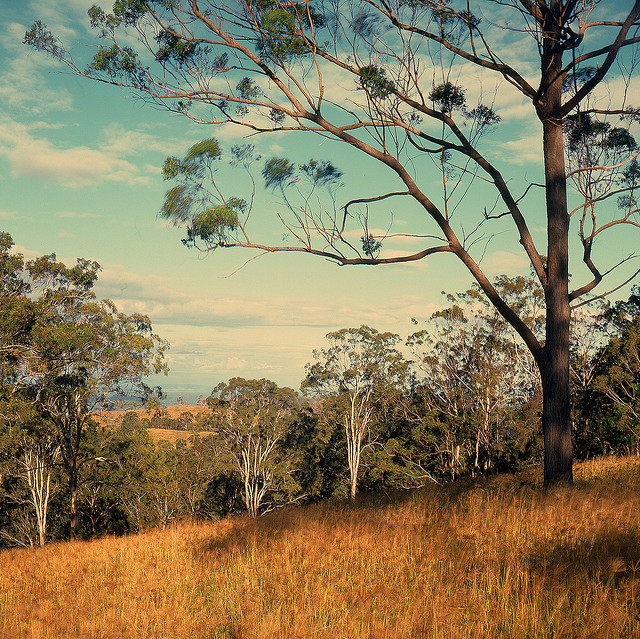
Habitat loss can be like death by a thousand cuts for ecosystems. Each conversion to farmland, housing, or pasture, when taken on its own, may seem a small, inconsequential nick on the surface of a vast planet. But together, and over decades and centuries, these cuts add up, leaving only tiny remnants of the original scattered across the landscape. The result can be devastating for animals and plants which depend on the original ecosystem. Yet unlike the grisly metaphor drawn from an ancient Chinese torture, the wounds of habitat loss are not entirely fatal. Farms and subdivisions may not supplant virgin forest or grasslands, but they need not be inhospitable wastelands, either.
![]() The field of ecology typically focuses on the leftovers of habitat conversion—the bits and pieces that somehow evaded plows and bulldozers. But just as no island is truly separated from the rest of the world, habitat remnants remain connected by the fields and yards that constitute the interstitial spaces. Known as “the matrix,” such spaces are important to the continued vitality of habitat fragments. In fact, according to new research out of Australia, the qualities of the matrix may matter more to the survival of native animal species than characteristics of the remnants themselves.
The field of ecology typically focuses on the leftovers of habitat conversion—the bits and pieces that somehow evaded plows and bulldozers. But just as no island is truly separated from the rest of the world, habitat remnants remain connected by the fields and yards that constitute the interstitial spaces. Known as “the matrix,” such spaces are important to the continued vitality of habitat fragments. In fact, according to new research out of Australia, the qualities of the matrix may matter more to the survival of native animal species than characteristics of the remnants themselves.
The matrix in the study are primarily cattle stations prevalent in the Toowoomba Regional Shire in southern Queensland. The area has been grazed heavily since the early 1900s, and pastoral uses are still the predominant land use, though urban development has been increasing in recent years. To quantify the amount of human influence within the matrix, the researchers measured a host of variables, mostly pertaining to roads and ranging from length to width to driving surface and even road kill statistics. They also closely studied the forest patches within the matrix and surveyed their resident mammal populations.
Many previous studies have focused on remnants’ size, shape, and geographic relationship to one another. This study did that, too, but also investigated the matrix itself. Of all possible landscape characteristics, the intensity of human development and number of tall trees within the matrix exerted more influence than any other.
To see how the matrix plays a role in this case, imagine you’re part of a group of people who are stranded on one of those islands, and your island doesn’t have everything you need to survive. Other islands do, though, so you’d need to set sail from time to time, just as the animals in the forest remnants may have to cross a pasture or pass through a neighborhood. The island metaphor is often used to describe how habitat remnants and their inhabitants interact with each other. Typically, people wax lyrical about the size, shape, and distance separating the islands. In this case, however, its not just the span of open water between the islands that matters, but the qualities of that water.
Neither the sea nor the matrix are absolute barriers, but they aren’t entirely hospitable, either.
Now let’s say you had a choice of islands on which to be stranded. Which would you pick? Quite obviously you’d prefer an island close to the mainland, but let’s say that’s out of the question. In lieu of that, you’d probably pick one that’s surrounded by calm seas so that exploring nearby islands would be infinitely easier. Some shallow waters between islands might be nice, too, to anchor your boat when you needed to take a rest. And if I were you, I’d also go for one with a bit of elevation to avoid high tides or tsunamis.
If those three wishes were granted, you’d probably have a good chance of living to a ripe old age. Conveniently, those wishes mirror what mammals in the Toowoomba study seemed to prefer, too. The researchers found fewer mammals traversing heavily developed areas—analogous to rough seas—and more where tall trees provided cover from predators—calm seas. The animals also favored a matrix with more nooks to roost or hide as they travelled—similar to shallow water for anchorage. Finally, the best remnants were those where human activities didn’t encroach too often—akin to higher elevation islands that guard against tides and tsunamis.
As a stranded soul, you wouldn’t have much influence over the ocean. But as stewards of the matrix, we decide its flora, its structure, and its ease of passage for animals. The biggest difference we can make is in reducing our developed footprint. The changes don’t have to be as drastic as ripping up subdivisions or farms. They could be as simple as carving roads only where they are most needed or avoiding areas where animals frequently tread. And failing that, plant trees.
Sources:
Brady, M., McAlpine, C., Miller, C., Possingham, H., & Baxter, G. (2009). Habitat attributes of landscape mosaics along a gradient of matrix development intensity: matrix management matters Landscape Ecology, 24 (7), 879-891 DOI: 10.1007/s10980-009-9372-6
Brady, M., McAlpine, C., Possingham, H., Miller, C., & Baxter, G. (2011). Matrix is important for mammals in landscapes with small amounts of native forest habitat Landscape Ecology DOI: 10.1007/s10980-011-9602-6
Photo by Shaun Johnston.
Related post: